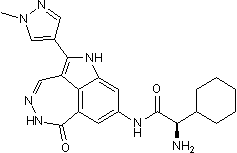In fact, mutants defective in antiphagocytosis are cleared at the initial stage of infection in Peyer’s patches and mesenteric lymph nodes. YopK and antiphagocytosis are inextricably linked. For several years, YopK has been suspected to Mepiroxol affect the Yop translocation pore. Herein, we show that YopK localized with the translocators YopB and YopD in the membrane fraction of infected cells. In addition, YopK can be found inside infected host cells �C presumably at the zone of bacteria-host cell contact. Interestingly, we observed that RACK1 also accumulates at the site of bacterial attachment to host cells and immediately upon activation of b1-integrins. We believe that this RACK1 localization is a prerequisite for productive blocking of phagocytosis since such a location would enable RACK1 to interact with YopK associated with the T3SS. Indeed, using independent proteinprotein binding assays, we could demonstrate this interaction. Together, these data suggest that YopK functions as a sensor and mediator of productive effector translocation. Thus, it is feasible that the YopK-RACK1 binding contributes to efficient antiphagocytosis where the association of YopK with the translocation pore ensures that translocated effector proteins are immediately exposed to their key target represented by signaling proteins involved in b1integrin-mediated Albaspidin-AA internalization. Interesting in this context is that RACK1, located at peripheral initial adhesion structures, has been shown to bind to focal adhesion kinase, which constitutes a target of the antiphagocytic effector YopH. From this work, we suggest that RACK1 serves as a recognition site for YopK to obtain a precise spatial translocation of antiphagocytic effectors allowing instant targeting of the phagocytic machinery. At first glance however, this might be difficult to reconcile considering that antiphagocytosis works fine in the absence of YopK, or both YopK and RACK1, but not in the absence of RACK1. In this respect, consider the critical finding that RACK1 RNAi cells resist the antiphagocytic effect of  wild type Y. pseudotuberculosis, but not of the yopK mutants. Thus, the key to unlocking this conundrum is to understand how yopK mutants suppress the RACK1 minus phenotype. The most likely reason for this is that these mutants show an overtranslocation phenotype, resulting in excessive delivery of Yop effectors into the host cell. Although effector delivery in the absence of YopK would be random and unorganized, their shear excess inside the cell will ensure that they still find and inactivate the critical target within the necessary time-frame. Therefore, this excess of effectors would overcome any need for YopK-RACK1 recognition; after all, only in the presence of YopK is RACK1 required for antiphagocytosis! Consistent with this is the avirulent phenotype of yopK mutants; surplus delivery of effectors is clearly detrimental for bacterial survival in vivo. The yopK mutants were cleared after a week of infection, likely as a consequence of damaging effects on host cells resulting in increased recruitment of immune cells and/or inundating the host with antigenic epitopes against which it can trigger a more robust and effective immune response. These mutants might also display reduced in vivo fitness because of the high energetic cost associated with Yop effector over-translocation. Whatever the reason, it suggests that RACK1 targeting by YopK is a key step in the controlled, target-directed process of effector delivery and a requirement for virulence. Antiphagocytosis by Yersinia is immediate, which contrasts to other pathogenic bacteria harboring a T3SS such as Enteropathogenic E. coli and Enterohemorrhagic E. coli that can induce an antiphagocytosis-like response after prolonged bacteria-host cell exposure. Since YopK is unique to the Yersinia T3SS, we argue that its interaction with RACK1 forms the basis for the immediate blocking of phagocytosis, a hallmark of this pathogen. We suggest that this also applies for Y. pestis during the extracellular stages of infection. Y. pestis do not express a functional invasin.
wild type Y. pseudotuberculosis, but not of the yopK mutants. Thus, the key to unlocking this conundrum is to understand how yopK mutants suppress the RACK1 minus phenotype. The most likely reason for this is that these mutants show an overtranslocation phenotype, resulting in excessive delivery of Yop effectors into the host cell. Although effector delivery in the absence of YopK would be random and unorganized, their shear excess inside the cell will ensure that they still find and inactivate the critical target within the necessary time-frame. Therefore, this excess of effectors would overcome any need for YopK-RACK1 recognition; after all, only in the presence of YopK is RACK1 required for antiphagocytosis! Consistent with this is the avirulent phenotype of yopK mutants; surplus delivery of effectors is clearly detrimental for bacterial survival in vivo. The yopK mutants were cleared after a week of infection, likely as a consequence of damaging effects on host cells resulting in increased recruitment of immune cells and/or inundating the host with antigenic epitopes against which it can trigger a more robust and effective immune response. These mutants might also display reduced in vivo fitness because of the high energetic cost associated with Yop effector over-translocation. Whatever the reason, it suggests that RACK1 targeting by YopK is a key step in the controlled, target-directed process of effector delivery and a requirement for virulence. Antiphagocytosis by Yersinia is immediate, which contrasts to other pathogenic bacteria harboring a T3SS such as Enteropathogenic E. coli and Enterohemorrhagic E. coli that can induce an antiphagocytosis-like response after prolonged bacteria-host cell exposure. Since YopK is unique to the Yersinia T3SS, we argue that its interaction with RACK1 forms the basis for the immediate blocking of phagocytosis, a hallmark of this pathogen. We suggest that this also applies for Y. pestis during the extracellular stages of infection. Y. pestis do not express a functional invasin.